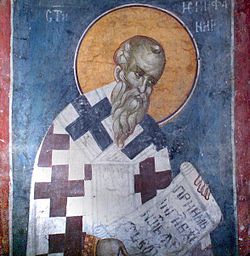Gračanica

Gračanica is a Serbian community in Kosovo, centered around the Gračanica Monastery and about 10 km from Pristina. Since the end of conflict, this town has functioned as a center for the remaining Serbian community in Kosovo.
Understand
[edit]Gračanica or Graçanicë (Albanian: Graçanica) is a town and municipality located in the Pristina District of Kosovo. As of 2024, the town has an estimated population of 19,371 residents.
Located approximately 10 kilometers east of Pristina, the town is best known for the Gračanica Monastery, a UNESCO World Heritage Site and one of the most important Serbian Orthodox monuments from the 14th century. The town has grown around the monastery and serves as a cultural and administrative center.
Following the 1999 Kosovo War, Gračanica evolved from a small village into a regional center, providing administrative services and support to the Kosovo Serb community, particularly those living south of the Ibar River, estimated at around 75,000 people. Under the terms of the 2013 Brussels Agreement, Gračanica was intended to be part of the Community of Serb Municipalities, a proposed self-governing association of Serb-majority municipalities in Kosovo. However, the agreement has not been fully implemented.
History
[edit]The earliest recorded mention of Gračanica appears in a 1303 letter from Pope Benedict IX, referring to the village as Grazaniza. It was also mentioned in King Stefan Milutin’s founding charter of the Gračanica Monastery in 1321. The town’s name is believed to originate from the Slavic word Gradac, meaning a fortified place or town.
During the 15th century, Gračanica developed into a notable commercial center and maintained an active Ragusan (Dubrovnik) trading community until the 17th century. The settlement is believed to have been abandoned in 1689, during the Habsburg advance into Kosovo as part of the Great Turkish War.
By 1901, historical records indicate that Gračanica consisted of approximately 60 households, all Serb, with around 400 inhabitants.
Get in
[edit]Coming from Pristina, the fastest and simplest way to reach Gračanica is by the road between Albi Mall and Viva Fresh, just off the road to Skopje. Continue on this main road for roughly 6 km, and you'll find yourself in Gračanica's city center. A metered radio taxi should charge less than €6 from Albi Mall, or roughly €10 from Pristina's city center.
Follow this same road through the end of town to reach the monastery.
You can also catch the bus to Gjilan leaving every 20 minutes from the main bus station in Pristina. The fare to Gračanica is €0.50 (payable inside the bus) and the trip lasts about 15 minutes.
You can also catch the 17 or 20 bus line. For the bus timetables, please refer to "Trafiku Urban" App or Website
Get around
[edit]The city is compact and easy to navigate, allowing visitors to reach most destinations comfortably on foot within a short amount of time.
See
[edit]
- 1 Gračanica monastery. Inscribed on the UNESCO World Heritage List—along with 3 other Serbian Orthodox churches/monasteries in Kosovo—as Medieval Monuments in Kosovo ([]). It was founded by the Serbian king Stefan Milutin in 1321 CE and built in the Byzantine tradition. Nearly all the fantastic artwork and architectural elements were added between the 14th-16th centuries CE.
- 2 Ulpiana Archeological Park (12 km to the south-east), ☏ +383 44189909, [email protected]. Monday-Friday 9:30-15:30, Saturday 10:00 – 14:00. Ulpiana is one of the largest ancient urban sites in Kosovo. In the beginning of the 1st century AD, with the Roman occupation of the Dardania, this multi-layered archaeological site was developed from an ancient Dardanian settlement into a typical Roman town. Municipium Ulpiana was found and urbanized by the Roman Emperor Marcus Ulpius Traianus (Trajan). It reached its highest development during the period between 3rd and 4th centuries AD, a time when it was called Municipium Ulpiana Splendidissima – the Splendid City of Ulpiana. Ulpiana was destroyed almost entirely by a destructive earthquake in 518. Emperor Justinian the Great rebuilt it but also renamed it Justinianasecunda. The fortified town of Ulpiana had an area of 35.5 hectares. In the eastern side was the castrum, a fortified field garrison that covered an area of 16 hectares. Ulpiana with its surrounding suburbium occupied about 120 hectares.

Do
[edit]- 1 Badovac Lake. Spend a day at the lake, taking in beautiful views of the countryside 7 km east of Gračanica. Stop and enjoy a magnificent steak at Villa Vilboni, near the far end of the lake.
- GuideKS (Kosovo Tourist Guides Association), [email protected], ☏ +383 49372639, [email protected]. umbrella organization of tourist guides in Kosovo. They will put you in touch with a local guide suitable for your activity.
- 2 Anija Restaurant amusement park. A park with (ballpark 30m) Eiffel Tower replica, kids playgrounds, an artificial lake with a boat, and a restaurant.
Eat
[edit]- 1 Ognjište. You've left Pristina - time for a pork chop! Take a taxi or park near the main road and walk, to avoid circuitous paths down one-way roads. ~€10.
- 2 Hotel Gracanica, Ul. Dragana Ristica b.b. (500 m from the main road, follow the road signs), ☏ +386 49 764 000, [email protected]. lunch with a view, traditional dishes, Sunday brunch €10. main dishes from €5.
- 3 Restoran Mimoza, ☏ +381 65 208 4868.
- 4 Ethno House (Etno Kuca). Local and traditional cuisine
Drink
[edit]- 1 Sabaja Brewery, ☏ +383 49 582-000. Coming from Pristina, you'll drive past the Sabaja craft beer brewing firm's headquarters just past the American Hospital on the western approach to Gračanica.
Sleep
[edit]- 1 Hotel Gracanica, Ul. Dragana Ristica b.b. (500 m from the main road, follow the road signs)), ☏ +383 49 764 000, [email protected]. Eco-friendly multiethnic boutique hotel under Swiss management with pool, garden and wonderful view Single €50/56, double €72/82, studio €120/130.
- 2 Hotel Europa, ☏ +383 44 537 988.


 Français
Français Italiano
Italiano




